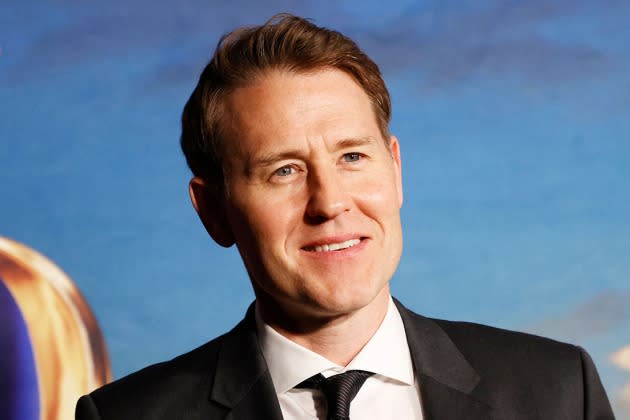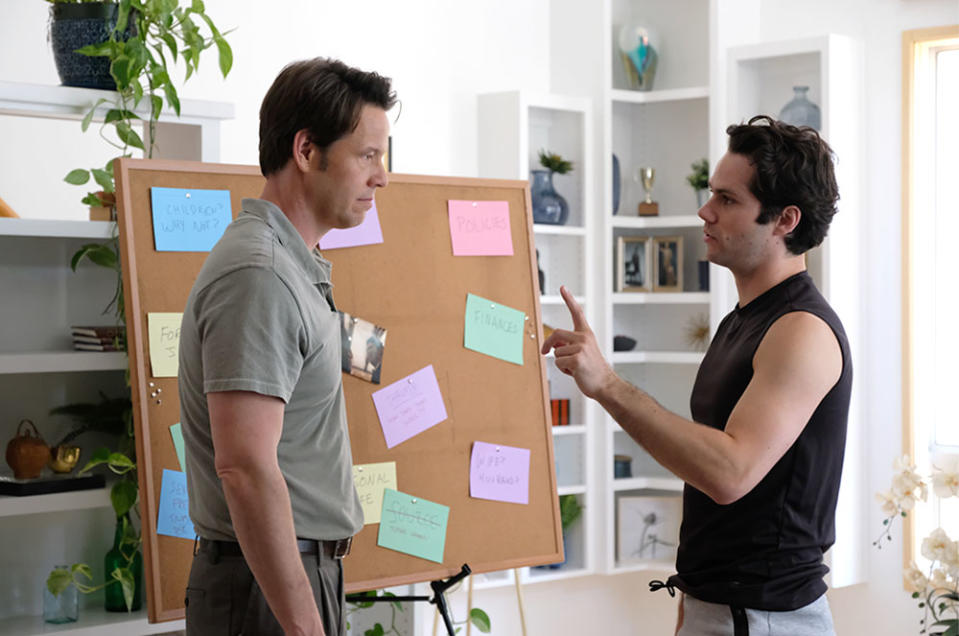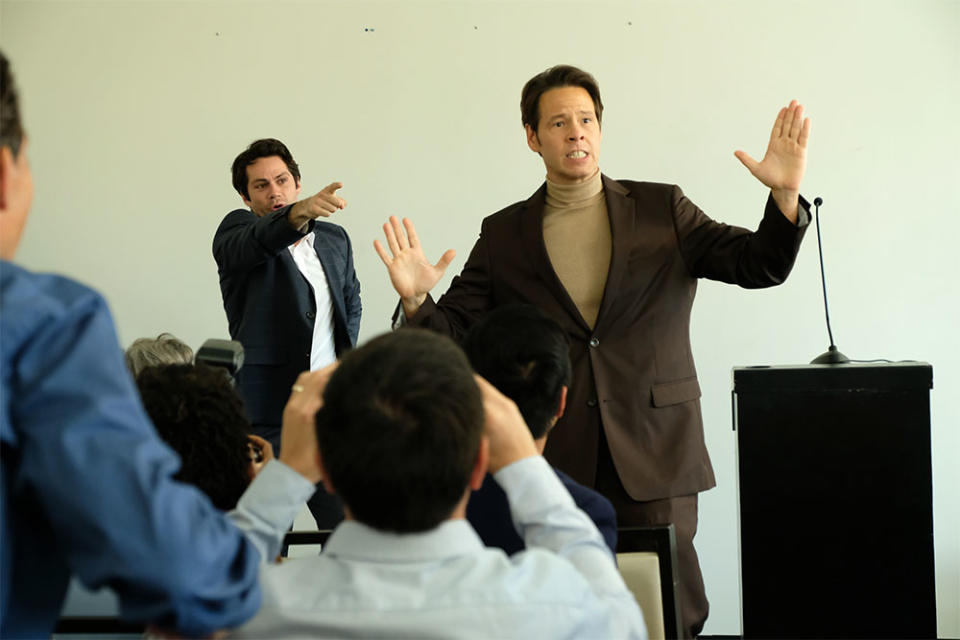‘Maximum Truth’ Director David Stassen Teams Up With Dylan O’Brien and Ike Barinholtz to Take on Political Grifters

The Maximum Truth brain trust of David Stassen and Ike Barinholtz have a history.
The two Chicagoans first met each other at summer camp when they were 7 years old, and they eventually became best friends as teenagers. Shortly thereafter, they formulated a plan to get their college degrees and then take a crack at Hollywood as writing and producing partners, with Barinholtz also serving as the comedic performer of the duo. Their story is very similar to Canada’s Seth Rogen and Evan Goldberg, making Stassen and Barinholtz their American counterparts, a comparison that Rogen himself supported recently. So Rogen’s involvement in Stassen and Barinholtz’s Maximum Truth and their Hulu limited series History of the World, Part II makes all the more sense.
More from The Hollywood Reporter
How Ike Barinholtz's Dad Landed at the Lovable Center of Amazon Freevee's 'Jury Duty'
'History of the World, Part II': Ike Barinholtz on Mel Brooks' Advice and a Potential Part III
In Maximum Truth, Stassen’s feature directorial debut, Barinholtz plays an attorney and “political consultant” named Rick Klingman. He’s Saul Goodman if Saul Goodman was completely ineffective, and together with his trusty sidekick, Simon Tarnum (Dylan O’Brien), they’re the Wet Bandits of political grifting. Beth Grant’s wealthy character, Mary Jo Nackserson, hires Klingman to dig up dirt on a Democratic Congressional candidate (Max Minghella), and with Simon in tow, the pair continually make fools of themselves as they grasp at straws.
For Stassen, his political mockumentary rips directly from headlines and chyrons, commenting on the many real-life political grifters who lead with allegations, fundraise off of those allegations and then constantly move the goalposts when it comes time to produce any evidence at a publicized event they’ve engineered.
“As Ike calls it, we’re in the ‘Age of the Grifter.’ We just wanted to shine a light on this world of political bad actors, people acting in bad faith and people who will say anything for money, fame and the television camera,” Stassen tells The Hollywood Reporter.
Stassen needed the perfect accomplice to complement Barinholtz’s Klingman, and so the partners went out to O’Brien, who also doesn’t shy away from politics. He instantly understood the world being parodied and committed in no time, creating a showier take on Simon Tarnum than the more reserved iteration on the page. O’Brien has always had a knack for comedy, but he’s elevated himself in recent years thanks to Curb Your Enthusiasm, Not Okay and The Other Two.
“Dylan, just out of the gate, brought a bigger energy. He was a counterbalance to Ike in a great way,” Stassen says. “In the scene where he’s showing off his punching speed to camera, Dylan just started doing that in the moment, and we ended up getting three takes of it because we thought it was so funny. So that was all him, and he definitely did surprise me.”
Below, during a recent conversation with THR, Stassen also discusses the ins and outs of Rogen’s cameo, before explaining how The Mindy Project’s set was essential to his present-day directing and showrunning duties.
Well, I spoke to Seth Rogen recently, and I brought up the idea of you and Ike Barinholtz being the American version of him and Evan Goldberg. And after his trademark laugh, he endorsed the idea.
Wow.
So it’s fitting that he cameos in Maximum Truth. Did you first go through the proper channels, or did it all begin with a text?
First, it was a text, and then you alert the proper channels to get into the contract. But yeah, it was a friendly ask. I think Ike texted Seth and he said, “Yes, of course,” but he was shooting Pam & Tommy at the time. So me and Seth’s assistant became very close friends over text, while figuring out a window. So it was like, “When do we have two hours? What morning or afternoon?” But it came together; it just took some planning.
Did you and Ike go back and forth for quite a while to make sure that you gave him something extra ridiculous?
[The opening of the film] was the original idea. We wanted to establish the start of the story. This guy, Rick Klingman [Barinholtz], is a low-level political operative, but he’s so obnoxious that he has managed to permeate a few parts of popular culture. And so we just wanted a celebrity like Seth to play himself. He was our first choice, and we were lucky he could do it, but we just wanted to show that Rick has reached a certain level of notoriety. Seth also got to improv a lot of his stuff. He understood the character that he was making fun of, and he knew the world of these political grifters. And so he knew where to take the simple speech we gave him.

So, for the uninitiated, what are the CliffsNotes of your history with Ike?
The CliffsNotes version is that we met at sports camp when we were in third grade. We’re both from Chicago. We went to different elementary schools, and then he joined my high school. So I’ve known him since third grade, but we became best friends when we were 14 years old. So, pretty soon into high school, we started messing around with my dad’s camcorder, making really stupid videos in our basement. And then we both went off to college knowing that we wanted to reconvene in L.A. when we were 22. And that’s pretty much what we did. We moved out to L.A. a little bit after I graduated college, and we got a really dingy apartment together. He bussed tables, I worked the front desk at a hotel and we wrote bad movies at night in our free time. And so that was the start of learning how to write.
And how many scripts did the two of you write together before you were finally produced?
Including TV pilots, we probably wrote eight-to-ten scripts, and the last couple got us meetings. We did the water tour. We wrote one called The Heat is On, and it was about four friends who graduate college with no prospects. And so they robbed a bank. 20 years later, their lives are stuck in a rut, and they get back together and rob another bank to save one of them from some financial trouble. It brought up all these emotional issues and became a spark in all their lives, so that was the one we took out before Central Intelligence. So, The Heat Is On got us a lot of meetings until we sold Central Intelligence.
The notable difference between you/Ike and Seth/Evan is that you guys don’t co-direct like they do. What made you go solo in that regard?
Well, we tried to co-direct on season three of The Mindy Project. Mindy [Kaling] asked us to direct, and we went in thinking we would direct together. We directed a series of shorts for Comedy Central over the summer to create our co-directors’ reel, and then we went in front of the DGA board. They famously don’t like writing teams trying to direct, but we made our argument to them anyway. We could have walked in with Jesus Christ and they still wouldn’t have granted us a co-directing waiver. So we decided to try and direct together, and then go back to them. I’d put my name on our first episode and then Ike would put his name on our second episode, but soon after, we just realized that it was easier if one person did it. Seth and Evan can do it; some people can do it. But honestly, it was just easier to have one person answer all the questions. A lot of directing is answering questions from department heads, like, “What color should the schoolkid’s lunch box be?” So I might say purple, but then the prop master will go and ask Ike who says red. So there was some of that. There were no arguments; it was just to streamline the process. And since we do share a sense of humor and a sensibility, we were both comfortable with the other person directing, especially since it’s usually a script that we’ve written and shepherded together.
Cutting your teeth on The Mindy Project, was that experience invaluable to the sets you’ve been on since then including Maximum Truth?
Yeah, it really is about the 10,000-hour theory, not that I am an expert in anything. It’s just about being on set and seeing what every single person on a crew does and how they’re all valuable. I was on set for 50 or 55 episodes before I directed, and I needed every one of those episodes on set before I directed. Just being there and putting in the time and seeing the setups and watching the director every week make a different choice was invaluable. You learn how to rely on the department heads, who really do help you look good. So The Mindy Project was the best time. There were [117] episodes, and I was the set writer for most of them. So I loved adding jokes and helping the actors improvise. It was just a great time with some of my best friends.

So when did the idea for Maximum Truth begin to form?
It formed really fast sometime during Covid. Ike and I are pretty political. He’s even more politically minded than I am, and as he calls it, we’re in the “Age of the Grifter.” And grifting is just a great movie trope. You get great characters out of that idea, but we didn’t want to be preachy. We just wanted to shine a light on this world of political bad actors, people acting in bad faith and people who will say anything for money, fame and the television camera. It’s nothing new. Mark Twain wrote about politicians 150 years ago, but with the addition of social media, it’s more ever-present now. They’re just being caught in their lies more, and yet, they’re still somehow getting away with it. So doing it as a mockumentary just felt like a really fun way to capture this person [Rick Klingman] who thinks he’s the hero of his story. He doesn’t mind bringing a camera with him everywhere he goes, so you get to see him trip over himself repeatedly.
If somebody told you and Ike at age 16 that both of your feature directorial debuts would revolve around politics, would that have surprised you? [Writer’s Note: Barinholtz directed The Oath in 2018, with Stassen as producer.]
In a way, no, because we were interested in politics even in high school. At one point, we thought we might move to D.C. and do politics. And coming from Chicago, it’s such a politically minded place. There were stories of corruption and dirty aldermans and kickbacks, and it probably has something to do with the DNA of Maximum Truth. So, in a way, it’s not surprising, but I might have been more surprised if you told me that at the age of 30 or 32, versus the age of 16. In our early thirties, we were more into comedies and action comedies, but the ideas that sparked and that we wrote really fast happened to be politically based.
As you touched on moments ago, there are Rick Klingman-types on TV every day, and they lead with allegations and gloss over any evidence for such claims. And then they’ll fundraise off it all. Rick says something similar in the movie, but they know that if they repeat the lie enough times, a number of people will start to believe it. So you must’ve had no shortage of inspiration for people who basically shoot first and barely ask questions later.
Yeah, one of our producers, Patrick Rizzotti, is convinced that Maximum Truth should be a TV show, because, to your point, the ideas could just go on and on. Rick and Simon [Dylan O’Brien], or even Rick alone, could be a 500-episode show. There’s never-ending ideas of Rick being hired by the whaling industry, the oil lobby, whatever. Anybody could hire Rick, and he would say yes to anyone offering him a modicum of money and some clout. One of my “favorite” characters right now is the congressman from Queens [George Santos]. He’s quite the character, and he keeps on catching himself in lies. So Rick might run his campaign in 2024 for reelection.

Once you decided on the mockumentary approach, did shooting in the vein of Arrested Development, The Office and Review just become inevitable?
Yeah, after we wrote it and I was in prep to direct it, I watched This Is Spinal Tap for the 50th time, and that movie is incredible. It’s a comedy that still holds up 40 years later, and so that was another inspiration in all the ones you mentioned. I was really insistent that it feel like a documentary. I wanted the actors to be able to say their lines, naturally. I didn’t want them to have to say it word for word. I wanted the camera to feel like it was just catching the beginning or the ending of a moment. But you’re right; it was inevitable. I wanted it to feel like if you had never seen anything Ike was in and you didn’t watch The Maze Runner or Teen Wolf, you might not know that Ike and Dylan are actors. I wanted this to feel like it could be a real political documentary.
After shooting the script in the natural way you described, did you let these guys play if inspiration struck?
Yeah, I come from Chicago, the home of improv. I even worked at Second City, and so I’ve been to a million improv shows, but I am an uptight writer at the end of the day. And so it’s like, “Just get me 60 to 80 percent of the words on the page,” at least in their meaning, so that we have the story or a scene that moves the plot forward. So I always want to get that, and then, yes, if someone says something that’s funny, we’ll talk about it. But it’s never just, “Have a fun run.” It’s always with intention. There’s always some direction and some idea behind it.
Dylan O’Brien told me that you shot this in 12 days. Was that the final number?
That was the final number, yeah. Well, there was one day where we shot the talking-head pieces of Ike, separately. So that would be the 13th day.

What was the process of bringing Dylan on board? Did you have to woo him like an NBA free agent?
I thought we were gonna have to, but we just sent his agent the script. And then Dylan read it really fast and said that he was in. It was that simple. We had a Zoom with him, and he’s a pretty passionate person. He understood the subtext of what we were talking about, even though it’s a very silly comedy. So he got it and he was in immediately. It was just a matter of squeezing it in between a couple other things he was doing. But no, I didn’t have Benny the Bull waiting for him at O’Hare Airport, like the Chicago Bulls used to do for free agents. We didn’t buy him a Hummer like Shaq might have done. It just worked out.
The industry made a push for him to be an action guy, but his comedic chops have reached a whole new level in recent years (Curb Your Enthusiasm, Not Okay, The Other Two). Did they impress you as well?
Yeah, they did, and not because I didn’t think he was funny already. When you meet him and you talk to him, you’re like, “This is a very cool and funny guy.” It’s just that we had been picturing Simon on the page as someone who was a little stiffer, a little more reserved and just bubbling over with insecurity. He was kind of robotic to mask how insecure and faux masculine he is, but Dylan, just out of the gate, brought a bigger energy. He was a counterbalance to Ike in a great way, and I love the bigger character. It was a much better take on Simon than how I had originally pictured the character, but yeah, it was surprising. In the scene where he’s showing off his punching speed to camera, Dylan just started doing that in the moment, and we ended up getting three takes of it because we thought it was so funny. Every take would end when he and Ike would just burst out laughing because they couldn’t hold it in anymore. So that was all him, and he definitely did surprise me.
How guerilla did the filmmaking get? Did you ever have to play fast and loose?
No, it was all above board, but your question makes me think we did a good job of making it feel like it was documentary style. To what I said earlier, I wanted it to feel like Rick didn’t tell the hotel that the cameras were in there, or that he was sneaking the cameras into the restaurant. So, if anyone’s asking, we had permits.
Producing an independent film is no easy feat, so who are the unsung heroes of Maximum Truth? Who was instrumental in getting it to the finish line?
QC Entertainment’s Sean McKittrick, Ray Mansfield and Ted Hamm. They did The Oath with Ike, and so we knew them through that. They read the script and immediately said, “Yes, we’re in. We’re financing it.” Patrick Rizzotti was the boots-on-the-ground producer, and Keith Dunkerley, my DP and A-camera operator, helped me execute my vision and pushed me. He didn’t let a director with very little camera knowledge run the show, so he was very helpful.
Whenever Rick and Simon would get a dumb idea or a so-called break in the case, the composer would come in with a music cue that perfectly captured the moronic energy of these two guys.
Jeff Cardoni is another good [unsung hero] to mention. He was just the composer on White House Plumbers. He’s a friend and he did this truly as a favor. I think he lost money on Maximum Truth overall, but he wrote so many cues and added so much to the story.
So have you given your former Mindy colleague Chris Messina any notes on his David Falk in Air?
No notes. It was a perfect performance. But I always pictured David Falk as being about 6’1’’ or 6’2’’. That’s all I’ll say. (Laughs.)
You were the co-showrunner of History of the World, Part II, which is a limited sequel series to Mel Brooks’ History of the World, Part I (1981). Was there a day that stands out as the most surreal?
I grew up watching History of the World, Part I, and my brother and I would watch it to get to “Hitler on Ice” and “Jews in Space.” And then we shot “Hitler on Ice” and “Jews in Space” as part of reshoots [for Part II], and I directed those two sketches. And so directing Mel Brooks’ “Hitler on Ice” and “Jews in Space” were the most surreal moments. We also shot the Civil War stuff up at a ranch near Northridge, and we had a hundred guys in blue and gray uniforms with muskets and tents. I acted very, very badly in the opening scene, but to come from the world of sitcoms and comedy writing for movies, it was very cool to be shooting something like the Civil War.
To bring things back to Maximum Truth, can the truth still prevail at a time when so many powerful people are trying to make it scarce?
I’m always hopeful. I’m a cynical comedy writer, but also an optimist. It ain’t easy!
***
Maximum Truth is available in theaters and VOD on June 23rd. This interview was edited for length and clarity.
Best of The Hollywood Reporter

 Yahoo News
Yahoo News 
